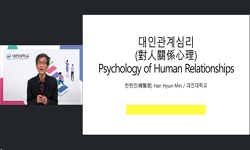Purpose: The career decision-making self-efficacy is a belief about an individual's ability to successfully ac-complish a given task. Students do not demonstrate an active attitude when they are faced with various stresses and anxiety about their own ...
http://chineseinput.net/에서 pinyin(병음)방식으로 중국어를 변환할 수 있습니다.
변환된 중국어를 복사하여 사용하시면 됩니다.
- 中文 을 입력하시려면 zhongwen을 입력하시고 space를누르시면됩니다.
- 北京 을 입력하시려면 beijing을 입력하시고 space를 누르시면 됩니다.

The Effects of Group Art Therapy on the Learned Helplessness and Career Decision Making Self-Efficacy of Mentally Challenged High School Students
한글로보기https://www.riss.kr/link?id=A108286301
- 저자
- 발행기관
- 학술지명
- 권호사항
-
발행연도
2022
-
작성언어
-
- 주제어
-
KDC
300
-
등재정보
KCI등재후보
-
자료형태
학술저널
-
수록면
65-79(15쪽)
- 제공처
-
0
상세조회 -
0
다운로드
부가정보
다국어 초록 (Multilingual Abstract)
Purpose: The career decision-making self-efficacy is a belief about an individual's ability to successfully ac-complish a given task. Students do not demonstrate an active attitude when they are faced with various stresses and anxiety about their own career or employment, and even some are passive and self-reliant, and they learn throughout their lives by becoming helpless when faced with numerous challenges due to their lack of responsi-bility or low self-esteem, thereby demonstrating symptoms of learned helplessness. As a result of the study which identified the relationship between learned helplessness and career path, the students with a high level of learned helplessness had a relatively high percentage of independent and dependent decisions in the overall process such as career selection, search, and decision relative to the students with a low sense of helplessness, and it was also claimed that the children with high learned helplessness showed relatively low means to solve career-related problem situations promptly. Hence, it is evident that by conducting the group art therapy, negative cognition and behavior can be changed through the group interaction and successful expe-riences in the art therapy process. This paper seeks to specifically examine the effects of group art therapy, which is very useful among the various treatment techniques which can help solve internal problems, on the learned helplessness and career decision making self-efficacy formed through the repeated failures.
Method: Twenty mentally challenged high school students enrolled in special classes at average high schools were assigned to the experimental group and 10 to the control group. The group program was conducted twice a week, for a total of 10 sessions of 80 minutes per session. For the pre-post-additional-tests on learned helpless-ness and career decision making self-efficacy, repeated measure analysis of variance and simple main effect analysis were performed.
Results: The experimental group in receipt of the group art therapy program was statistically significantly higher in the learned helplessness and career decision making self-efficacy scores than the control group both after and additional. Such results are meaning in that they help not only the mentally challenged high school students who are about to graduate, but also the mentally challenged high school students currently enrolled in the school to increase their self-confidence and self-esteem to ensure that they can make career choices that align with the reality through the positive understanding of themselves and the correct perception related changes.
Conclusion: The group art therapy helps to address issues and problems through deep insight into one's inner self, and helps to improve the self-esteem by having a positive self-image, further to being an important factor for improvement. Hence, through this study, the group art therapy program should make an active effort to give a sense of achievement for the human growth, convert negative motives to positive motives, and diversify the scope of application of group art therapy programs for addressing realistic problems.
목차 (Table of Contents)
- 1. Introduction
- 2. Theoretical Background
- 3. Research Method
- 4. Group Art Therapy Program
- 5. Data Processing
- 1. Introduction
- 2. Theoretical Background
- 3. Research Method
- 4. Group Art Therapy Program
- 5. Data Processing
- 6. Research Results
- 7. Discussion and Conclusion
- 8. References
- 9. Appendix
동일학술지(권/호) 다른 논문
-
- J-INSTITUTE
- Eunjoo Choi(Eunjoo Choi)
- 2022
- KCI등재후보
-
- J-INSTITUTE
- Kyungok Choi(Kyungok Choi)
- 2022
- KCI등재후보
-
- J-INSTITUTE
- Soonbok Won(Soonbok Won)
- 2022
- KCI등재후보
-
- J-INSTITUTE
- Migyeong Shin(Migyeong Shin)
- 2022
- KCI등재후보




 스콜라
스콜라



